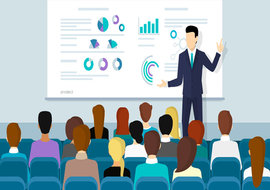
Research has shown a downward trend in the attention span for even the smallest task. New innovative trends are being developed from marketing to learning to ensure proper engagement and action.Among others, gamification has emerged as a revolutionary approach in learning and development (L&D).
By integrating game mechanics into educational experiences, organizations are transforming the way employees learn and grow. This innovative strategy enhances engagement and fosters a culture of continuous improvement and skill acquisition. Transforming important learning milestones into relatable experiences and tasks will transform the business landscape, let’s explore how.
What is Gamification?
Applying game elements—including points, badges, leaderboards, and challenges—to non-gaming situations, such as training and education, is known as gamification. The idea is to use people’s innate love of games to make learning more engaging, entertaining, and productive.
It is employed in a variety of settings, including education, marketing, workforce training, health and wellness, and customer engagement. Also, gamification, for example, can be used in educational applications to make learning more exciting for students, while businesses can use it to improve staff performance, increase customer loyalty, or reward both employees and customers. Gamification demands a grasp of the target audience, their motivations, and the context in which the approach is implemented.
Why Gamification Works
- Increased Engagement: Games are inherently engaging. By incorporating game-like elements into learning programs, participants are more likely to be motivated and invested in the material. This heightened engagement leads to better retention and application of knowledge.
- Enhanced Motivation: Gamification leverages intrinsic and extrinsic motivators. Achievements, rewards, and recognition (extrinsic) combined with the satisfaction of mastering a new skill or overcoming a challenge (intrinsic) create a powerful motivational framework.
- Instant Feedback: In a gamified environment, learners receive immediate feedback on their progress. This instant gratification helps individuals understand their strengths and areas for improvement, promoting a continuous learning loop.
- Safe Learning Environment: Games provide a risk-free setting where learners can experiment, make mistakes, and learn from them without real-world consequences. This encourages innovation and creativity.
- Collaboration and Competition: Gamification can foster both teamwork and healthy competition. Leaderboards and team-based challenges encourage learners to collaborate and strive for excellence, creating a dynamic and interactive learning atmosphere.
How to implement gamification in employee Learning and development
1. Identify Learning Objectives: Start by clearly defining what you aim to achieve through gamification. Whether it’s improving product knowledge, enhancing soft skills, or fostering leadership qualities, having clear objectives will guide your gamification strategy.
2. Understand Your Audience: Tailor the gamified elements to suit the preferences and needs of your learners. Consider factors like age, job role, and learning style to create a more personalized and effective experience.
3. Choose the Right Game Mechanics: Not all game elements will be suitable for every learning objective. Select mechanics that align with your goals—points and badges for motivation, leaderboards for competition, and scenarios for experiential learning.
4. Integrate with Existing Platforms: Ensure that your gamification strategy integrates seamlessly with your existing learning management systems (LMS) and other digital tools. This will make the transition smoother and enhance user experience.
5. Measure and Iterate: Continuously assess the effectiveness of your gamification efforts. Collect data on learner engagement, progress, and feedback to refine and improve the gamified components over time.
Success Stories
Several organizations have successfully harnessed the power of gamification in their L&D initiatives:
– Deloitte Leadership Academy: By incorporating leaderboards, badges, and missions, Deloitte significantly increased user engagement and course completion rates in its leadership training programs.
– Cisco’s Social Media Training Program: Cisco used a gamified approach to train employees on social media. Participants earned badges and points for completing modules, leading to higher participation and knowledge retention.
– Microsoft’s Language Quality Game: Microsoft developed a game to improve the quality of their product translations. Employees played the game to identify and fix language errors, resulting in higher-quality translations and increased employee engagement.
Takeaway
Gamification is not just a buzzword; it’s a powerful tool that can transform learning and development. By making learning more interactive, motivating, and fun, organizations can foster a culture of continuous improvement and skill development. As technology continues to evolve, the potential for gamification in L&D will only grow, offering new and exciting ways to engage and develop talent. Embrace gamification and unlock the full potential of your learning programs today.
Learn more about Outsourcing and how it can help your company.




